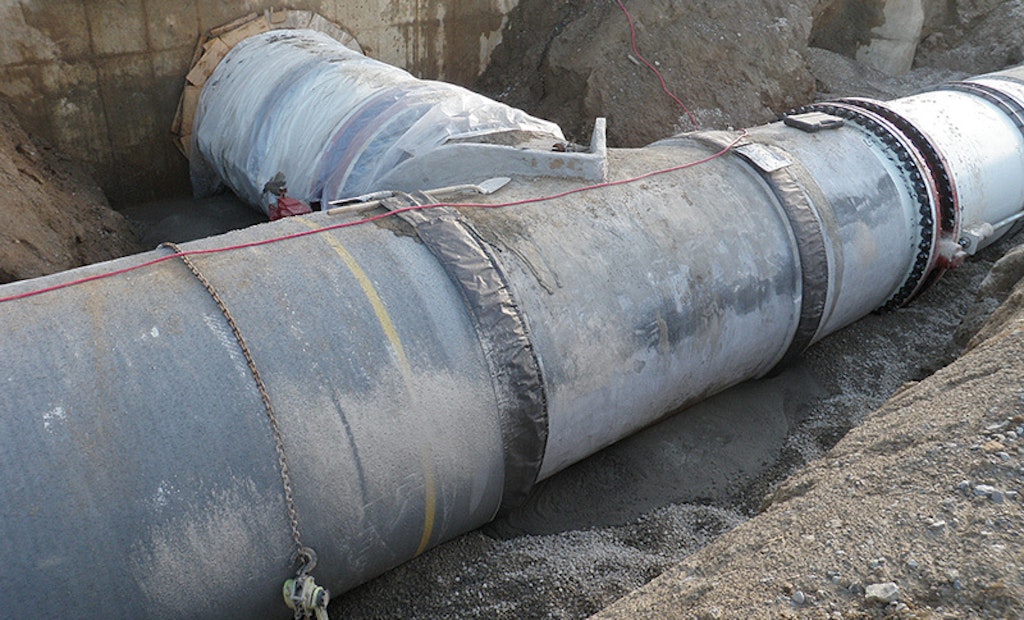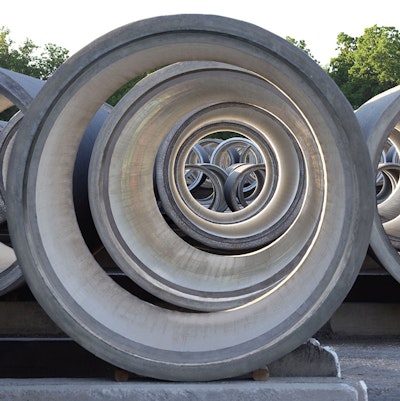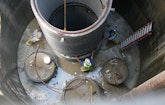
Interested in Infrastructure?
Get Infrastructure articles, news and videos right in your inbox! Sign up now.
Infrastructure + Get AlertsConcrete pressure pipe has been a go-to material for water and wastewater projects for almost 90 years.
While it has one of the longest histories of any material, concrete pressure pipe (CPP) also claims one of the lowest rates of failure. By combining the structural properties of steel and concrete, CPP is highly corrosion resistant, has superior strength and does not require special bedding and backfill procedures. In addition, over the years the CPP industry has continued to make its products even more durable and refine its installation procedures to ensure the pipe stands up to internal and external pressures as well as more corrosive soils.
Pressure Pipe 101
The category of concrete pressure pipe comprises two types of prestressed concrete cylinder pipe (PCCP) — L-301 and E-301 — as well as bar-wrapped concrete cylinder pipe, B-303.
PCCP starts with a concrete-lined steel cylinder (L-301 pipe) or a steel cylinder embedded in a concrete core cylinder (E-301 pipe). The structural core is helically wrapped with high-tensile-strength steel wire then coated with a layer of cement mortar to electrochemically protect the pipe against corrosion. The construction combines the compressive strength of concrete with the high tensile strength of steel to form a robust structure suitable for high performance and a long life across a wide range of loading conditions. The prestressing wire wrap places the steel cylinder or concrete core in a state of circumferential compression, allowing the pipe to withstand internal hydrostatic pressure and external loads.
L-301 pipe is available in diameters from 16 to 48 inches and laying lengths from 16 to 32 feet. It’s suitable for water distribution and transmission lines, wastewater lines, treatment plant process lines and industrial process piping. E-301 comes in 54- to 144-inch diameters and laying lengths from 12 to 24 feet. It’s most commonly used for water distribution and transmission lines, wastewater lines, treatment plant process lines, industrial process piping and power plant cooling water systems.
Bar-wrapped concrete cylinder pipe consists of a welded steel cylinder that is lined with mortar or concrete, helically wrapped with steel bar and then coated with a layer of mortar. This process combines the best of both materials — steel’s strength and concrete’s corrosion resistance and durability — into one strong, reliable pipe able to withstand significant internal water pressure as well as external loads. Bar-wrapped pipe’s design also allows for easy modifications in the field, such as adding a manhole outlet and performing simple repairs. B-303, often specified for water transmission mains, distribution feeder mains, treatment plants, intake and discharge lines and plant piping, is available in diameters from 10 to 72 inches and lengths from 20 to 35 feet.
Long service life
You can expect concrete pressure pipe to provide reliable service for decades. Some types of concrete pressure pipe have been in service for almost 90 years. In fact, the recent technical paper “Numbers Don’t Lie: PCCP Performance and Deterioration Based on a Statistical Review of a Decade of Condition Assessment Data,” reported on the electromagnetic and acoustic inspections of 118,808 pipe sections (about 2.1 million feet). In that inspected group, only 3.9 percent had electromagnetic signatures consistent with prestressing wire break damage. Alternatively, it was stated that 96.1 percent of the pipe sections did not have any damage and could be considered in “like new” condition.
Once installed, concrete pressure pipe requires little maintenance over its lifetime. Longevity does rely on proper installation — contractors should be familiar with and trained on CPP and work should be regularly inspected. Most important, installers should follow manufacturer’s recommendations for handling and storage, installation, bedding placement and joint grouting. Care should be taken to avoid damage to the pipe’s mortar coating before and during installation, including conducting a pre-installation inspection of the pipe and examining the trench for rocks and debris. After installation, the line should be marked and monitored, particularly if construction or directional drilling takes place nearby.
The pipe manufacturer is your best resource for ensuring proper installation and operation.
CPP at work in Milwaukee
Concrete pressure pipe is in service around the country, but the Harbor Siphons project in Milwaukee is a particularly unique display of the product’s capabilities. As part of the Milwaukee Metropolitan Sewerage District’s Overflow Reduction Plan, the Harbor Siphons project expanded the capacity of the district’s interceptor system to deliver sewage flows equal to the capacity of the North Wastewater Treatment Plant. Harbor Siphons brings all sanitary sewage from the sanitary system associated with the Jones Island Water Reclamation Facility through the new PCCP under a siphon arrangement across the harbor via a “deep tunnel” elevation. The increase in capacity by gravity/pressure to the plant reduces sewer overflows and residential backups.
To reach the water reclamation facility, which is located on a peninsula, crews installed 96-inch prestressed concrete cylinder pipe vertically 300 feet deep into the harbor, under the harbor and then vertically into the plant. The shafts and tunnels hold both L-301 and E-301 concrete pressure pipe in seven diameters ranging from 42 to 96 inches. The project required multiple types of pipe, large quantities of custom-designed fittings, mechanically restrained testable joints and specially designed lifting lugs.
Installing the pipes down into the vertical shafts called for tremendous coordination and preplanning; Hanson’s dual rubber o-ring testable joints allowed each joint to be air tested upon installation, an essential feature since the pipes were inaccessible once the installation process was completed. Along with the testable joints, PCCP was an ideal material for this application because of its ability to withstand the rigors of the installation and the resulting tunnel loads.
About the Author
Rick Deremiah, P.E., is Technical Resources Engineering Manager for Hanson Pressure Pipe.







